2024届高三英语复习:定语从句的语法课件(共40张PPT)
文档属性
| 名称 | 2024届高三英语复习:定语从句的语法课件(共40张PPT) |  | |
| 格式 | pptx | ||
| 文件大小 | 3.6MB | ||
| 资源类型 | 教案 | ||
| 版本资源 | 通用版 | ||
| 科目 | 英语 | ||
| 更新时间 | 2023-08-08 08:22:52 | ||
图片预览

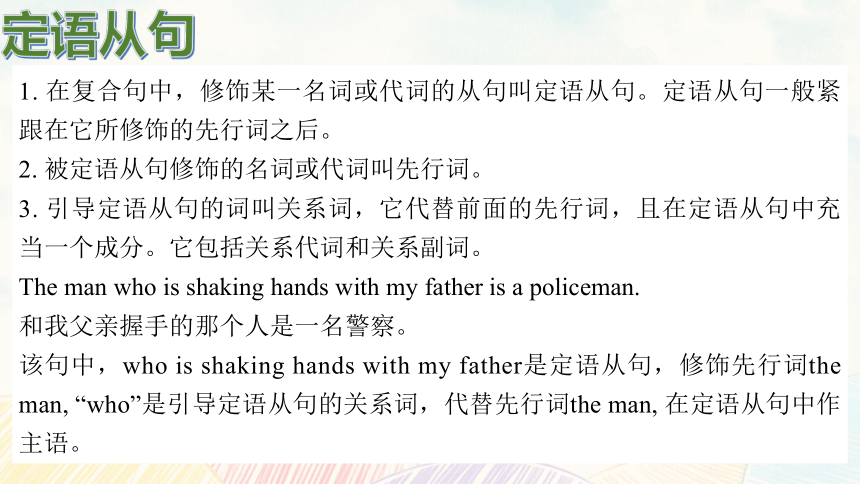

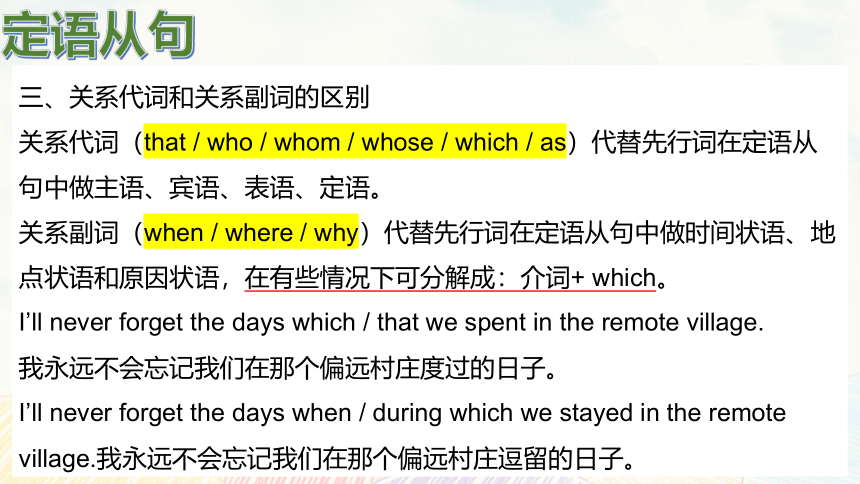

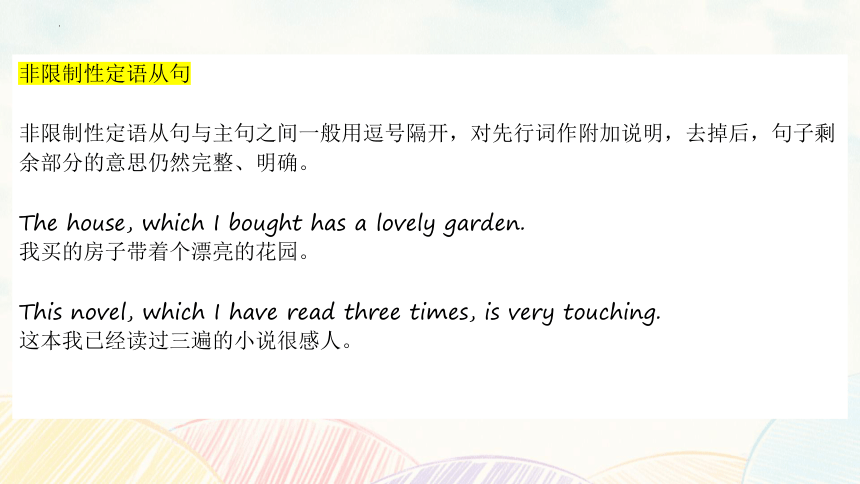
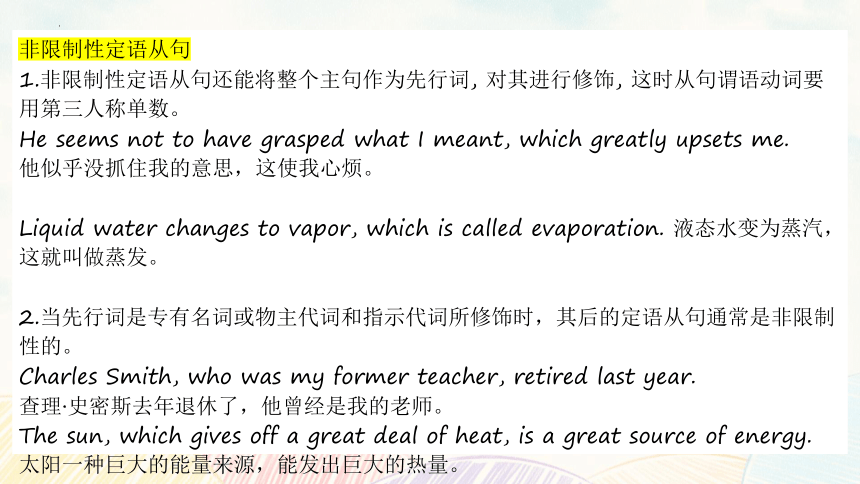
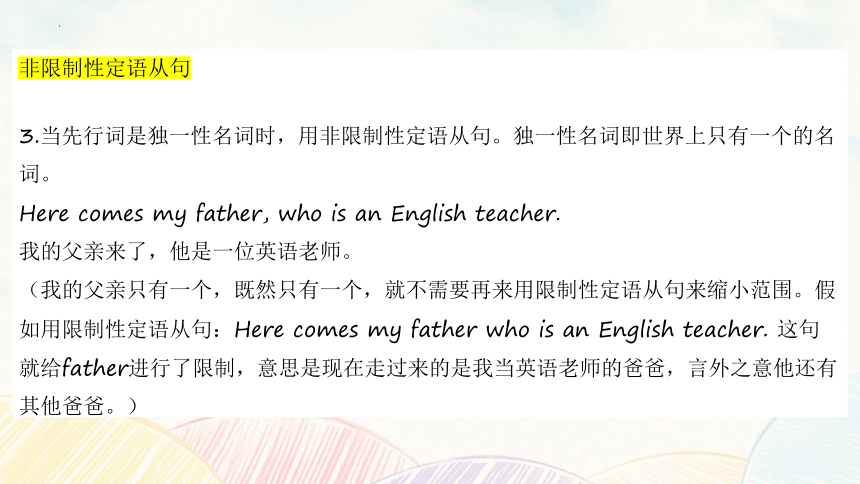
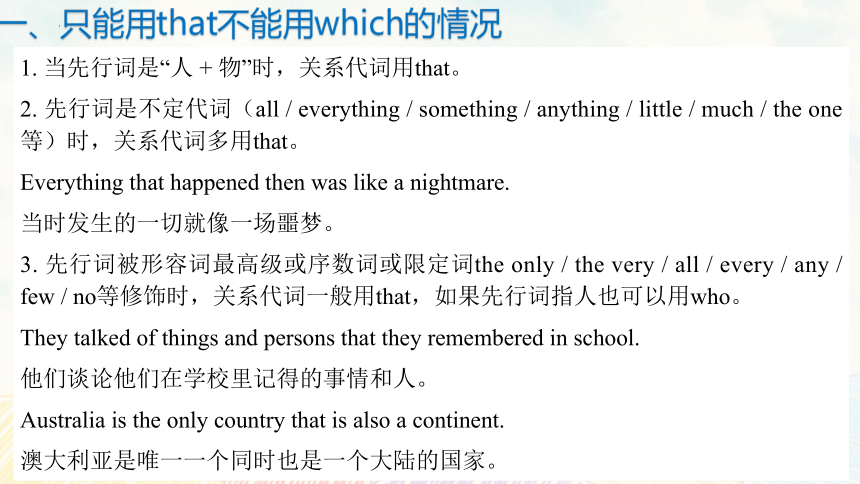
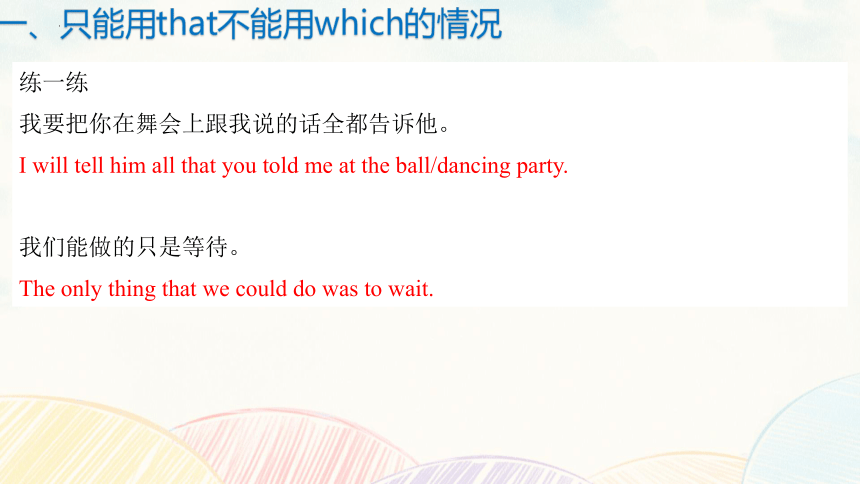
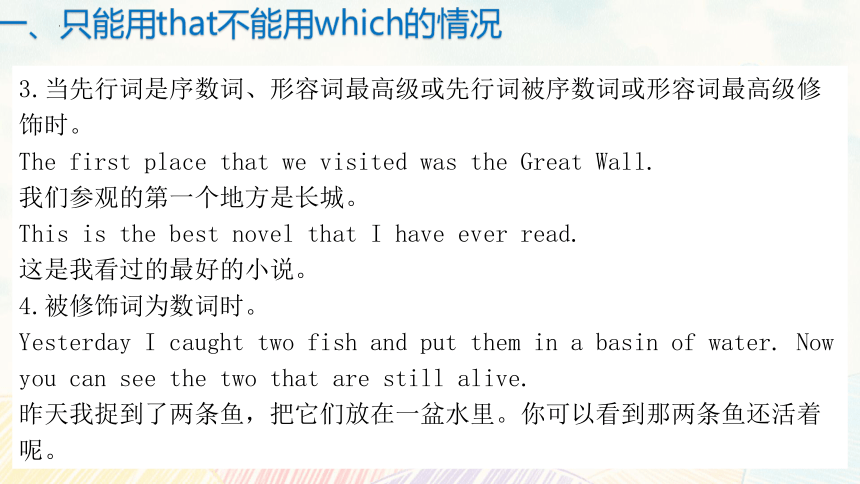
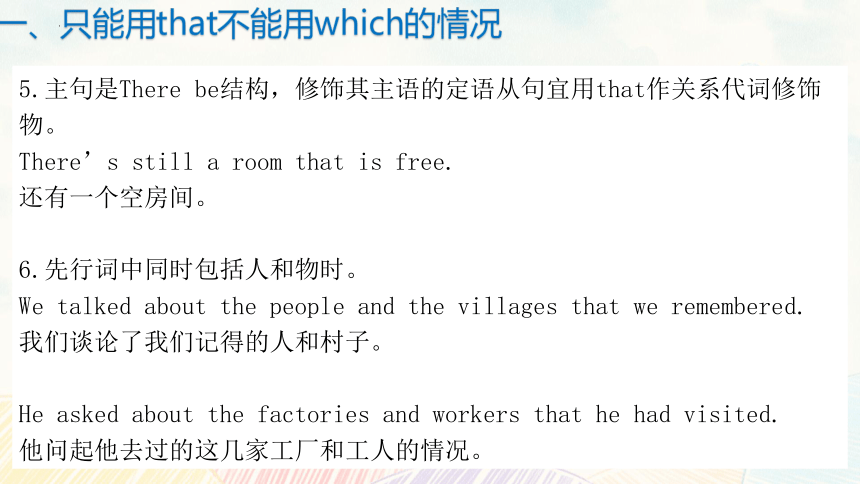
文档简介
(共40张PPT)
定语从句
1. 在复合句中,修饰某一名词或代词的从句叫定语从句。定语从句一般紧跟在它所修饰的先行词之后。
2. 被定语从句修饰的名词或代词叫先行词。
3. 引导定语从句的词叫关系词,它代替前面的先行词,且在定语从句中充当一个成分。它包括关系代词和关系副词。
The man who is shaking hands with my father is a policeman.
和我父亲握手的那个人是一名警察。
该句中,who is shaking hands with my father是定语从句,修饰先行词the man, “who”是引导定语从句的关系词,代替先行词the man, 在定语从句中作主语。
定语从句
二、基本结构
先行词(名词、代词)+(关系代词、关系副词)+ 陈述句语序。
The reason (that) he gave for being late was just an excuse.
他给出的迟到理由只是一个借口。
定语从句
练一练
他就是我昨天见的那个人。
He is the man whom/that I saw yesterday.
三、关系代词和关系副词的区别
关系代词(that / who / whom / whose / which / as)代替先行词在定语从句中做主语、宾语、表语、定语。
关系副词(when / where / why)代替先行词在定语从句中做时间状语、地点状语和原因状语,在有些情况下可分解成:介词+ which。
I’ll never forget the days which / that we spent in the remote village.
我永远不会忘记我们在那个偏远村庄度过的日子。
I’ll never forget the days when / during which we stayed in the remote village.我永远不会忘记我们在那个偏远村庄逗留的日子。
定语从句
限制性定语从句
限制性定语从句与主句之间不用逗号隔开,对先行词进行限定、修饰,如果去掉,剩余部分的意义便不完整、不明确。
She has found the necklace(that)she lost two weeks ago.
她找到她那条丢失两周的项链。
Do you remember the girl who taught us English
你还记得教我们英语的那个女孩吗?
This is the girl whom I met in the street.
这是我在街上遇到的那个女孩。
There is much that I wan to tell you.
我有很多想要告诉你的话。
非限制性定语从句
非限制性定语从句与主句之间一般用逗号隔开,对先行词作附加说明,去掉后,句子剩余部分的意思仍然完整、明确。
The house, which I bought has a lovely garden.
我买的房子带着个漂亮的花园。
This novel, which I have read three times, is very touching.
这本我已经读过三遍的小说很感人。
非限制性定语从句
1.非限制性定语从句还能将整个主句作为先行词, 对其进行修饰, 这时从句谓语动词要用第三人称单数。
He seems not to have grasped what I meant, which greatly upsets me.
他似乎没抓住我的意思,这使我心烦。
Liquid water changes to vapor, which is called evaporation. 液态水变为蒸汽,这就叫做蒸发。
2.当先行词是专有名词或物主代词和指示代词所修饰时,其后的定语从句通常是非限制性的。
Charles Smith, who was my former teacher, retired last year.
查理·史密斯去年退休了,他曾经是我的老师。
The sun, which gives off a great deal of heat, is a great source of energy.
太阳一种巨大的能量来源,能发出巨大的热量。
非限制性定语从句
3.当先行词是独一性名词时,用非限制性定语从句。独一性名词即世界上只有一个的名词。
Here comes my father, who is an English teacher.
我的父亲来了,他是一位英语老师。
(我的父亲只有一个,既然只有一个,就不需要再来用限制性定语从句来缩小范围。假如用限制性定语从句:Here comes my father who is an English teacher. 这句就给father进行了限制,意思是现在走过来的是我当英语老师的爸爸,言外之意他还有其他爸爸。)
1. 当先行词是“人 + 物”时,关系代词用that。
2. 先行词是不定代词(all / everything / something / anything / little / much / the one等)时,关系代词多用that。
Everything that happened then was like a nightmare.
当时发生的一切就像一场噩梦。
3. 先行词被形容词最高级或序数词或限定词the only / the very / all / every / any / few / no等修饰时,关系代词一般用that,如果先行词指人也可以用who。
They talked of things and persons that they remembered in school.
他们谈论他们在学校里记得的事情和人。
Australia is the only country that is also a continent.
澳大利亚是唯一一个同时也是一个大陆的国家。
一、只能用that不能用which的情况
练一练
我要把你在舞会上跟我说的话全都告诉他。
I will tell him all that you told me at the ball/dancing party.
我们能做的只是等待。
The only thing that we could do was to wait.
一、只能用that不能用which的情况
3.当先行词是序数词、形容词最高级或先行词被序数词或形容词最高级修饰时。
The first place that we visited was the Great Wall.
我们参观的第一个地方是长城。
This is the best novel that I have ever read.
这是我看过的最好的小说。
4.被修饰词为数词时。
Yesterday I caught two fish and put them in a basin of water. Nowyou can see the two that are still alive.
昨天我捉到了两条鱼,把它们放在一盆水里。你可以看到那两条鱼还活着呢。
一、只能用that不能用which的情况
5.主句是There be结构,修饰其主语的定语从句宜用that作关系代词修饰物。
There’s still a room that is free.
还有一个空房间。
6.先行词中同时包括人和物时。
We talked about the people and the villages that we remembered.
我们谈论了我们记得的人和村子。
He asked about the factories and workers that he had visited.
他问起他去过的这几家工厂和工人的情况。
一、只能用that不能用which的情况
7.当主句中有who, which时,而定语从句中也要用到who或which时,为了避免who…who, which…which等重叠,定语从句要用that引导。
Who is the man that is standing by the door
站在门边的那个男人是谁?
Which of the two cows that you keep produces more milk
你养的那两头奶牛中哪一个产奶多?
8.人或物在定语从句中表语时,用that引导定语从句,而that通常也可以省略。
He is no longer the man that he was.他不再是过去的他。
一、只能用that不能用which的情况
二、不能用that的情况
1. that不能引导非限定性定语从句。
2. 介词后不用that(介词后指人用whom,指物用which)。
Spam(垃圾邮件), which once meant a not-so-good kind of canned meat, now stands for unwanted junk email.
Spam曾经用来指不好的罐装肉,现在代表不想要的垃圾邮件。
John invited about 40 people to his wedding, most of whom are family members.
约翰邀请了大约40个人参加他的婚礼,其中大部分是他的家人。
二、不能用that的情况
(3)在一个句子中有两个定语从句,其中一个定语从句的关系代词用了that, 另一个宜用which。
Let me show you the novel that I borrowed from the library which was newly open to us.
我来给你看我从新开的图书馆里借来的那本小说。
(4)当关系代词后面有插入语时。
Here is the English grammar which, as I have told you, will help improve your English.
这就是我跟你说过的会有助于你学好英语的那本英语语法书。
二、不能用that的情况
(5)先行词为that时。
The clock is that which can tell us the time.
钟是报时的装置。
2.修饰人时只用who不用that的情况
(1)先行词为one, ones, anyone, those指代人时。
The person I want to learn from is one who studies hard and works well.
我最羡慕的是学习勤奋,工作出色的人。
(2)在There be结构中,修饰主语的定语从句宜用 who关系代词指代人。
There's a gentleman who wants to see you.有位先生想见你。
二、不能用that的情况
(3)当先行词有较长的后置定语时。
I met a foreigner in the park yesterday afternoon who could speak Chinese very well.
昨天下午我在公园里遇到一位中文讲得非常好的外国人。
(4)一个句子中带有两个定语从句,其中一个定语从句的关系代词是that, 另一个宜用who以避免重复。
The student that was praised at yesterday's meeting is the monitor who is very modest and works very hard.受到校长表扬的学生是位谦虚好学的班长。
注意:
当关系代词前面有介词时,只能用whom。
The person to whom this letter was addressed died three years ago.
这封信的收信人三年前就去世了。
二、不能用that的情况
(3)当先行词有较长的后置定语时。
I met a foreigner in the park yesterday afternoon who could speak Chinese very well.
昨天下午我在公园里遇到一位中文讲得非常好的外国人。
(4)一个句子中带有两个定语从句,其中一个定语从句的关系代词是that, 另一个宜用who以避免重复。
The student that was praised at yesterday's meeting is the monitor who is very modest and works very hard.受到校长表扬的学生是位谦虚好学的班长。
注意:
当关系代词前面有介词时,只能用whom。
The person to whom this letter was addressed died three years ago.
这封信的收信人三年前就去世了。
二、不能用that的情况
whose可以指人或物,在定语从句中作定语,后跟名词。
whose + 名词 = 名词 + of which / whom = of which / whom + 名词
Look out! Don’t get close to the house whose roof is being repaired.
留神不要靠近正在修理屋顶的房子。
The teacher had a careful talk with Tom, the major problem of whom is poor study habits.
老师和汤姆进行了认真的交谈,汤姆的主要问题是学习习惯不好。
三、whose引导的定语从句
在确定其中的介词时,可从以下三方面入手:
1. 句子的意思;2. 先行词的意义;3. 从句中的动词固定搭配。
He was educated at a local grammar school, after which he went on to Cambridge.
他在当地一所文法学校接受教育,之后又去了剑桥大学。
This is the farm on which he worked two years ago.
这是他两年前工作的农场。
In the dark street there was not a single person to whom she could turn for help.
在黑暗的街道上,没有一个人可以向她求助。
四、“介词+关系代词”引导的定语从句中介词的选择
当situation, point, case, activity, scene, atmosphere, condition, stage及period, festival, occasion等作先行词时,要注意具体情况具体分析:先行词在从句中作主语、宾语和表语时,用关系代词that / which引导从句;先行词在从句中作状语时,用关系副词where / when或“介词 + which”引导从句,表示在某种特定的情形下。
I had reached a point in my career where I needed to decide which way to go.
在我的职业生涯中,我已经到了需要决定走哪条路的地步。
What are some situations where body language is the only form of communication
在哪些情况下,肢体语言是唯一的交流形式?
五、一些特殊的先行词
1. 用在固定搭配the same …as;as...as; such…as;so...as中。
This is the same bag as I lost last week.
这是我上周丢的同一个袋子。
This is such a difficult problem as I can’t work out.
这是一个我解不出来的难题。
六、as 的用法
as引导限制性定语从句
在主句中常有the same, so或such与as相呼应, as在定语从句中可作主语、宾语、主语补足语等。as引出的定语从句带有比较意义,从句常常只写出比较部分,但as本身不可省略。
He used such expressions as he could find in the texts.
他使用在课文中可以找到的那些词语。
They stayed for the night in the same room as they had once rented.
他们在他们曾租用过的同一房间过夜。
六、as 的用法
as引导限制性定语从句
注意:
在the same…后也可用that引导定语从句,但含义有所不同。that引出的从句,指的是与先行词同一的事物,而as引导的从句指的是与先行词同类的事物。
This is the same bag as I lost yesterday.
这个包和我昨天丢失的包的样子是同样的。
This is the same bag that I lost yesterday.
这就是我昨天丢失的那个包。
六、as 的用法
as引导非限定性定语从句,意思为“正如”常见习惯用语有:
as often happens 正如经常发生的那样
as is often the case 通常情况是这样
as is mentioned above 正如上面提到的
as is known / as we know 众所周知
As is mentioned above, the number of senior high school students is increasing.
如上所述,高中生的人数正在增加。
As I have pointed out, it is important to include vegetables in our diet.
正如我所指出的,在我们的饮食中包括蔬菜是很重要的。
六、as 的用法
注意:
as, which引导非限制性定语从句的区别:
a.都可以代整个主句,相当于and this或and that.
b.as可放在句首,而which不能。
c.as代表前面的整个主句并在从句中作主语时,从句中的谓语必须是系动词;如果为行为动词,则从句中的关系代词只能用which.
It rained hard yesterday, which prevented me from going to the park.
昨天下大雨,这使得我不能去公园。
六、as 的用法
先行词是way,当引导词在从句中作状语时,关系词用in which, that或者省略;当引导词在从句中作主语或宾语时,用that/which引导(作宾语时,引导词也可以省略)。比较:
The way (that / which) he explained to us was quite simple.
他向我们解释的方式很简单。
(把从句补充完整:he explained the way to us,可以看出引导词在从句中作explained的宾语。)
The way (that / in which) he explained the sentence was simple.
他解释这句话的方式很简单。
(把从句补充完整:he explained the sentence in the way,可以看出引导词在从句中作状语。)
七、注意way(方式)后接定语从句时的引导词
在定语从句中,定语从句对先行词起修饰作用,引导词that在从句中作主语或宾语;在同位语从句中, 同位语从句对同位名词内容起解释说明作用,引导词that不作任何成份。
The idea that computers can recognize human voices surprises many people. (同位语从句)
计算机可以识别人声的想法让许多人感到惊讶。
The idea that he put forward surprises many people. (定语从句)
他提出的想法使许多人感到惊讶。
八、that引导同位语从句和定语从句的区别
1. 关系代词作从句的主语时,从句中谓语动词的人称和数要与先行词保持一致,先行词是句子时,从句的谓语动词用单数。
2. “one of + 复数名词”作先行词时,关系代词在从句中作主语,从句的谓语动词常用复数,但当代词前有the, the only, the very等修饰时,从句的谓语动词用单数。
Titanic is the only of these wonderful movies that has been produced in Hollywood. 《泰坦尼克号》是唯一一部在好莱坞制作的精彩电影。
China Today attracts a worldwide readership, which shows that more and more people all over the world want to learn about China.
《今日中国》吸引了全世界的读者,这表明全世界越来越多的人想了解中国。
九、定语从句中的主谓一致
在定语从句中作状语的关系副词when, where, why的用法
(1)先行词表示时间时,定语从句中的谓语动词如果是不及物动词,用关系副词when或介词+which;如果是及物动词,用which或that都行。
I still remember the days when(=on which)we lived together.
我仍然记得我们在一起的时光。
(2)先行词表示地点时,如果定语从句中谓语动词是不及物动词,用关系副词where或介词+which;如果是及物动词时,用which或that都可以。
This is the small village where (=in which) Chairman Mao ever lived.
这就是毛主席曾经居住过的小村庄。
(3)表示原因时,why前的先行词是表示原因的名词reason。
Can you tell me the reason why (=for which) you didn't finish your homework
你能告诉我你没有完成作业的原因吗?
than和but也可用作关系代词引导定语从句
(1)than用作关系代词,在定语从句中作主语或宾语。
You spent more money than was intended to be spent.
你花的钱超过了预定的数额。(than是关系代词,在句中作主语,其先行词是money)
(2)but作为关系代词引导定语从句时,一般同具有否定意义的主句连用,其先行词可以是人,也可以是物,但只用于限制性定语从句中。
There was not a single student in my class but learnt a lot from him.(but=who did not)
我班上每一个学生都从他那里学到了很多东西。
因此,在这种句子中,but在意义上等于“that...not”,“who...not”,“which...not”。
1.关系词的省略
(1)在从句中作宾语时。
关系代词在从句中作宾语时可省略
I have regretted the decision (that/which) I made years ago.
我为我几年前做的决定感到后悔过。
(2)在定语从句中作表语时。
that在从句中作表语时可省略
She is all (that) a teacher should be.她具备一个老师应该具备的所有条件。
(3)在从句中作补语时。
that在从句中作补语时可省略
I'm not the fool (that) you thought me.我不是你以前所认为的那个傻子了。
(4)作状语时的省略。
a.当先行词是reason, 且在定语从句中作原因状语时, 可以用关系副词why或关系代词that, 也可以省略。
The reason (why/that) he failed was his laziness.他失败的原因是因为他懒惰。
That is the reason I did it.那就是我做那件事的原因。
b.当先行词是way, 且在定语从句中作方式状语时, 关联词可用in which或that, 也可以省略。
The way (in which/that) these comrades look at problems is wrong.
这些同志看待问题的方式是错误的。
That was the way (in which/that) she worked the problem out.
她就是用那种办法解决问题的。
c.当先行词是time时, 关联词可用when, that或省略。
The second time (that) I saw him was in 2000.
我第二次见到他是在2000年。
I don't know the exact time (when/that) the sports meeting will take place.
我不知道运动会举办的确切时间。
d.当先行词是place时, 关联词可用where, that或省略。
The place(where/that) we will have our picnic is not decided yet.
我们举行野餐的地点还没定下来。
This is the right place he was born.
这儿就是他的出生地。(注意:句末不可用介词in)
2.定语从句与同位语从句的区别
(1)引导同位语从句的that是连词, 在从句中不充当任何成份, 而引导定语从句的that是关系代词, 除起连接作用外, 还在从句中充当主语、宾语或表语等。
The idea that computers can recognize human voices surprises many people.
计算机能够识别人的声音的想法使许多人感到惊奇。
(同位语从句,that在从句中不充当任何成份)
The idea that he gave surprises many people.
他提出的观点令许多人感到吃惊。
(定语从句,that在从句中作gave的宾语)
(2)引导词的不同 what, how, if, whatever 等可引导名词性从句,但不引导定语从句。
I have no idea what has happened to him.我不知道他发生了什么事。
2.定语从句与同位语从句的区别
(3)同位语从句与前面的名词是同位关系, 即说明它前面名词的内容;而定语从句与前面的名词是修饰与被修饰关系, 即限定它前面的名词范围, 或补充一些情况。
The news that he told me is that Tom would go abroad next year.
他告诉我的消息是汤姆明年将出国.
(第一个that引导的从句是定语从句, that在从句中作宾语)
The news that Tom would go abroad is told by him.汤姆要出国的消息是他讲的.
(同位语从句, that在句中不作任何成分)
The news that l have passed the math exam is true.我通过了数学考试这一消息是真的。
(同位语从句, 即从句所表达的意思就是前面名词的内容)
The news that he told me just now is true.他刚才告诉我的消息是真的。
(定语从句, 从句对前面名词起修饰限制作用,即“他告诉我的”那个消息,而不是别的消息)
2.定语从句与同位语从句的区别
(4)定语从句的先行词是名词,代词或句子;而同位语从句的先行词只能是名词,而且仅限于idea, fact, hope,news,doubt,truth,information,suggestion,question, belief,conclusion等少数名词。而且when,where,why引导的定语从句的先行词一定分别是表示时间、地点和原因的名词,而三者引导的同位语从句的先行词则肯定不是表示时间、地点和原因的名词。
I have no idea when they will come.
我不知道他们什么时候来。(同位语从句)
I'll never forget the days when I lived there.
我永远不会忘记我住在那儿的日子。(定语从句)
1. Scientists have advanced many theories about why human beings cry tears, none of _________has been proved.
2. We will put off the picnic in the park until next week, _________the weather may be better.
3. I live next door to a couple _________children often make a lot of noise.
4. Many young people, most of _________were well-educated, _________ (head) for remote regions to chase their dreams.
5. It is a truly delightful place, _________looks the same as it must have done 100 years ago with its winding streets and pretty cottages.
练一练
which
when
whose
whom
headed
which
6. Opposite is St.Paul’s Church, _________you can hear some lovely music.
7. The number of smokers, _________is reported, has dropped by 17 percent in just one year.
8. The boss of the company is trying to create an easy atmosphere _________his employees enjoy their work.
9. Please send us all the information _________ you have about the candidate for the position.
10. Happiness and success often come to those _________are good at recognizing their own strengths.
练一练
where
as
where
that
who
圣保罗教堂
11. I don’t become a serious climber until the fifth grade, _________I went up to rescue a kite that _________ (stick) in the branches of a tree.
12. He wrote a letter _________he explained what had happened in the accident.
13. He was generous with his time, _________ which I was very grateful.
14. One concern relates to a lack of control over _________appears on the Internet.
15. Researchers have discovered that “night milk” contains more melatonin(褪黑激素), _________ has been proven to help people feel _________ (sleep) and reduce_________ (anxious)
练一练
was stuck
when
where / in which
for
what
which
sleepy
anxiety
定语从句
1. 在复合句中,修饰某一名词或代词的从句叫定语从句。定语从句一般紧跟在它所修饰的先行词之后。
2. 被定语从句修饰的名词或代词叫先行词。
3. 引导定语从句的词叫关系词,它代替前面的先行词,且在定语从句中充当一个成分。它包括关系代词和关系副词。
The man who is shaking hands with my father is a policeman.
和我父亲握手的那个人是一名警察。
该句中,who is shaking hands with my father是定语从句,修饰先行词the man, “who”是引导定语从句的关系词,代替先行词the man, 在定语从句中作主语。
定语从句
二、基本结构
先行词(名词、代词)+(关系代词、关系副词)+ 陈述句语序。
The reason (that) he gave for being late was just an excuse.
他给出的迟到理由只是一个借口。
定语从句
练一练
他就是我昨天见的那个人。
He is the man whom/that I saw yesterday.
三、关系代词和关系副词的区别
关系代词(that / who / whom / whose / which / as)代替先行词在定语从句中做主语、宾语、表语、定语。
关系副词(when / where / why)代替先行词在定语从句中做时间状语、地点状语和原因状语,在有些情况下可分解成:介词+ which。
I’ll never forget the days which / that we spent in the remote village.
我永远不会忘记我们在那个偏远村庄度过的日子。
I’ll never forget the days when / during which we stayed in the remote village.我永远不会忘记我们在那个偏远村庄逗留的日子。
定语从句
限制性定语从句
限制性定语从句与主句之间不用逗号隔开,对先行词进行限定、修饰,如果去掉,剩余部分的意义便不完整、不明确。
She has found the necklace(that)she lost two weeks ago.
她找到她那条丢失两周的项链。
Do you remember the girl who taught us English
你还记得教我们英语的那个女孩吗?
This is the girl whom I met in the street.
这是我在街上遇到的那个女孩。
There is much that I wan to tell you.
我有很多想要告诉你的话。
非限制性定语从句
非限制性定语从句与主句之间一般用逗号隔开,对先行词作附加说明,去掉后,句子剩余部分的意思仍然完整、明确。
The house, which I bought has a lovely garden.
我买的房子带着个漂亮的花园。
This novel, which I have read three times, is very touching.
这本我已经读过三遍的小说很感人。
非限制性定语从句
1.非限制性定语从句还能将整个主句作为先行词, 对其进行修饰, 这时从句谓语动词要用第三人称单数。
He seems not to have grasped what I meant, which greatly upsets me.
他似乎没抓住我的意思,这使我心烦。
Liquid water changes to vapor, which is called evaporation. 液态水变为蒸汽,这就叫做蒸发。
2.当先行词是专有名词或物主代词和指示代词所修饰时,其后的定语从句通常是非限制性的。
Charles Smith, who was my former teacher, retired last year.
查理·史密斯去年退休了,他曾经是我的老师。
The sun, which gives off a great deal of heat, is a great source of energy.
太阳一种巨大的能量来源,能发出巨大的热量。
非限制性定语从句
3.当先行词是独一性名词时,用非限制性定语从句。独一性名词即世界上只有一个的名词。
Here comes my father, who is an English teacher.
我的父亲来了,他是一位英语老师。
(我的父亲只有一个,既然只有一个,就不需要再来用限制性定语从句来缩小范围。假如用限制性定语从句:Here comes my father who is an English teacher. 这句就给father进行了限制,意思是现在走过来的是我当英语老师的爸爸,言外之意他还有其他爸爸。)
1. 当先行词是“人 + 物”时,关系代词用that。
2. 先行词是不定代词(all / everything / something / anything / little / much / the one等)时,关系代词多用that。
Everything that happened then was like a nightmare.
当时发生的一切就像一场噩梦。
3. 先行词被形容词最高级或序数词或限定词the only / the very / all / every / any / few / no等修饰时,关系代词一般用that,如果先行词指人也可以用who。
They talked of things and persons that they remembered in school.
他们谈论他们在学校里记得的事情和人。
Australia is the only country that is also a continent.
澳大利亚是唯一一个同时也是一个大陆的国家。
一、只能用that不能用which的情况
练一练
我要把你在舞会上跟我说的话全都告诉他。
I will tell him all that you told me at the ball/dancing party.
我们能做的只是等待。
The only thing that we could do was to wait.
一、只能用that不能用which的情况
3.当先行词是序数词、形容词最高级或先行词被序数词或形容词最高级修饰时。
The first place that we visited was the Great Wall.
我们参观的第一个地方是长城。
This is the best novel that I have ever read.
这是我看过的最好的小说。
4.被修饰词为数词时。
Yesterday I caught two fish and put them in a basin of water. Nowyou can see the two that are still alive.
昨天我捉到了两条鱼,把它们放在一盆水里。你可以看到那两条鱼还活着呢。
一、只能用that不能用which的情况
5.主句是There be结构,修饰其主语的定语从句宜用that作关系代词修饰物。
There’s still a room that is free.
还有一个空房间。
6.先行词中同时包括人和物时。
We talked about the people and the villages that we remembered.
我们谈论了我们记得的人和村子。
He asked about the factories and workers that he had visited.
他问起他去过的这几家工厂和工人的情况。
一、只能用that不能用which的情况
7.当主句中有who, which时,而定语从句中也要用到who或which时,为了避免who…who, which…which等重叠,定语从句要用that引导。
Who is the man that is standing by the door
站在门边的那个男人是谁?
Which of the two cows that you keep produces more milk
你养的那两头奶牛中哪一个产奶多?
8.人或物在定语从句中表语时,用that引导定语从句,而that通常也可以省略。
He is no longer the man that he was.他不再是过去的他。
一、只能用that不能用which的情况
二、不能用that的情况
1. that不能引导非限定性定语从句。
2. 介词后不用that(介词后指人用whom,指物用which)。
Spam(垃圾邮件), which once meant a not-so-good kind of canned meat, now stands for unwanted junk email.
Spam曾经用来指不好的罐装肉,现在代表不想要的垃圾邮件。
John invited about 40 people to his wedding, most of whom are family members.
约翰邀请了大约40个人参加他的婚礼,其中大部分是他的家人。
二、不能用that的情况
(3)在一个句子中有两个定语从句,其中一个定语从句的关系代词用了that, 另一个宜用which。
Let me show you the novel that I borrowed from the library which was newly open to us.
我来给你看我从新开的图书馆里借来的那本小说。
(4)当关系代词后面有插入语时。
Here is the English grammar which, as I have told you, will help improve your English.
这就是我跟你说过的会有助于你学好英语的那本英语语法书。
二、不能用that的情况
(5)先行词为that时。
The clock is that which can tell us the time.
钟是报时的装置。
2.修饰人时只用who不用that的情况
(1)先行词为one, ones, anyone, those指代人时。
The person I want to learn from is one who studies hard and works well.
我最羡慕的是学习勤奋,工作出色的人。
(2)在There be结构中,修饰主语的定语从句宜用 who关系代词指代人。
There's a gentleman who wants to see you.有位先生想见你。
二、不能用that的情况
(3)当先行词有较长的后置定语时。
I met a foreigner in the park yesterday afternoon who could speak Chinese very well.
昨天下午我在公园里遇到一位中文讲得非常好的外国人。
(4)一个句子中带有两个定语从句,其中一个定语从句的关系代词是that, 另一个宜用who以避免重复。
The student that was praised at yesterday's meeting is the monitor who is very modest and works very hard.受到校长表扬的学生是位谦虚好学的班长。
注意:
当关系代词前面有介词时,只能用whom。
The person to whom this letter was addressed died three years ago.
这封信的收信人三年前就去世了。
二、不能用that的情况
(3)当先行词有较长的后置定语时。
I met a foreigner in the park yesterday afternoon who could speak Chinese very well.
昨天下午我在公园里遇到一位中文讲得非常好的外国人。
(4)一个句子中带有两个定语从句,其中一个定语从句的关系代词是that, 另一个宜用who以避免重复。
The student that was praised at yesterday's meeting is the monitor who is very modest and works very hard.受到校长表扬的学生是位谦虚好学的班长。
注意:
当关系代词前面有介词时,只能用whom。
The person to whom this letter was addressed died three years ago.
这封信的收信人三年前就去世了。
二、不能用that的情况
whose可以指人或物,在定语从句中作定语,后跟名词。
whose + 名词 = 名词 + of which / whom = of which / whom + 名词
Look out! Don’t get close to the house whose roof is being repaired.
留神不要靠近正在修理屋顶的房子。
The teacher had a careful talk with Tom, the major problem of whom is poor study habits.
老师和汤姆进行了认真的交谈,汤姆的主要问题是学习习惯不好。
三、whose引导的定语从句
在确定其中的介词时,可从以下三方面入手:
1. 句子的意思;2. 先行词的意义;3. 从句中的动词固定搭配。
He was educated at a local grammar school, after which he went on to Cambridge.
他在当地一所文法学校接受教育,之后又去了剑桥大学。
This is the farm on which he worked two years ago.
这是他两年前工作的农场。
In the dark street there was not a single person to whom she could turn for help.
在黑暗的街道上,没有一个人可以向她求助。
四、“介词+关系代词”引导的定语从句中介词的选择
当situation, point, case, activity, scene, atmosphere, condition, stage及period, festival, occasion等作先行词时,要注意具体情况具体分析:先行词在从句中作主语、宾语和表语时,用关系代词that / which引导从句;先行词在从句中作状语时,用关系副词where / when或“介词 + which”引导从句,表示在某种特定的情形下。
I had reached a point in my career where I needed to decide which way to go.
在我的职业生涯中,我已经到了需要决定走哪条路的地步。
What are some situations where body language is the only form of communication
在哪些情况下,肢体语言是唯一的交流形式?
五、一些特殊的先行词
1. 用在固定搭配the same …as;as...as; such…as;so...as中。
This is the same bag as I lost last week.
这是我上周丢的同一个袋子。
This is such a difficult problem as I can’t work out.
这是一个我解不出来的难题。
六、as 的用法
as引导限制性定语从句
在主句中常有the same, so或such与as相呼应, as在定语从句中可作主语、宾语、主语补足语等。as引出的定语从句带有比较意义,从句常常只写出比较部分,但as本身不可省略。
He used such expressions as he could find in the texts.
他使用在课文中可以找到的那些词语。
They stayed for the night in the same room as they had once rented.
他们在他们曾租用过的同一房间过夜。
六、as 的用法
as引导限制性定语从句
注意:
在the same…后也可用that引导定语从句,但含义有所不同。that引出的从句,指的是与先行词同一的事物,而as引导的从句指的是与先行词同类的事物。
This is the same bag as I lost yesterday.
这个包和我昨天丢失的包的样子是同样的。
This is the same bag that I lost yesterday.
这就是我昨天丢失的那个包。
六、as 的用法
as引导非限定性定语从句,意思为“正如”常见习惯用语有:
as often happens 正如经常发生的那样
as is often the case 通常情况是这样
as is mentioned above 正如上面提到的
as is known / as we know 众所周知
As is mentioned above, the number of senior high school students is increasing.
如上所述,高中生的人数正在增加。
As I have pointed out, it is important to include vegetables in our diet.
正如我所指出的,在我们的饮食中包括蔬菜是很重要的。
六、as 的用法
注意:
as, which引导非限制性定语从句的区别:
a.都可以代整个主句,相当于and this或and that.
b.as可放在句首,而which不能。
c.as代表前面的整个主句并在从句中作主语时,从句中的谓语必须是系动词;如果为行为动词,则从句中的关系代词只能用which.
It rained hard yesterday, which prevented me from going to the park.
昨天下大雨,这使得我不能去公园。
六、as 的用法
先行词是way,当引导词在从句中作状语时,关系词用in which, that或者省略;当引导词在从句中作主语或宾语时,用that/which引导(作宾语时,引导词也可以省略)。比较:
The way (that / which) he explained to us was quite simple.
他向我们解释的方式很简单。
(把从句补充完整:he explained the way to us,可以看出引导词在从句中作explained的宾语。)
The way (that / in which) he explained the sentence was simple.
他解释这句话的方式很简单。
(把从句补充完整:he explained the sentence in the way,可以看出引导词在从句中作状语。)
七、注意way(方式)后接定语从句时的引导词
在定语从句中,定语从句对先行词起修饰作用,引导词that在从句中作主语或宾语;在同位语从句中, 同位语从句对同位名词内容起解释说明作用,引导词that不作任何成份。
The idea that computers can recognize human voices surprises many people. (同位语从句)
计算机可以识别人声的想法让许多人感到惊讶。
The idea that he put forward surprises many people. (定语从句)
他提出的想法使许多人感到惊讶。
八、that引导同位语从句和定语从句的区别
1. 关系代词作从句的主语时,从句中谓语动词的人称和数要与先行词保持一致,先行词是句子时,从句的谓语动词用单数。
2. “one of + 复数名词”作先行词时,关系代词在从句中作主语,从句的谓语动词常用复数,但当代词前有the, the only, the very等修饰时,从句的谓语动词用单数。
Titanic is the only of these wonderful movies that has been produced in Hollywood. 《泰坦尼克号》是唯一一部在好莱坞制作的精彩电影。
China Today attracts a worldwide readership, which shows that more and more people all over the world want to learn about China.
《今日中国》吸引了全世界的读者,这表明全世界越来越多的人想了解中国。
九、定语从句中的主谓一致
在定语从句中作状语的关系副词when, where, why的用法
(1)先行词表示时间时,定语从句中的谓语动词如果是不及物动词,用关系副词when或介词+which;如果是及物动词,用which或that都行。
I still remember the days when(=on which)we lived together.
我仍然记得我们在一起的时光。
(2)先行词表示地点时,如果定语从句中谓语动词是不及物动词,用关系副词where或介词+which;如果是及物动词时,用which或that都可以。
This is the small village where (=in which) Chairman Mao ever lived.
这就是毛主席曾经居住过的小村庄。
(3)表示原因时,why前的先行词是表示原因的名词reason。
Can you tell me the reason why (=for which) you didn't finish your homework
你能告诉我你没有完成作业的原因吗?
than和but也可用作关系代词引导定语从句
(1)than用作关系代词,在定语从句中作主语或宾语。
You spent more money than was intended to be spent.
你花的钱超过了预定的数额。(than是关系代词,在句中作主语,其先行词是money)
(2)but作为关系代词引导定语从句时,一般同具有否定意义的主句连用,其先行词可以是人,也可以是物,但只用于限制性定语从句中。
There was not a single student in my class but learnt a lot from him.(but=who did not)
我班上每一个学生都从他那里学到了很多东西。
因此,在这种句子中,but在意义上等于“that...not”,“who...not”,“which...not”。
1.关系词的省略
(1)在从句中作宾语时。
关系代词在从句中作宾语时可省略
I have regretted the decision (that/which) I made years ago.
我为我几年前做的决定感到后悔过。
(2)在定语从句中作表语时。
that在从句中作表语时可省略
She is all (that) a teacher should be.她具备一个老师应该具备的所有条件。
(3)在从句中作补语时。
that在从句中作补语时可省略
I'm not the fool (that) you thought me.我不是你以前所认为的那个傻子了。
(4)作状语时的省略。
a.当先行词是reason, 且在定语从句中作原因状语时, 可以用关系副词why或关系代词that, 也可以省略。
The reason (why/that) he failed was his laziness.他失败的原因是因为他懒惰。
That is the reason I did it.那就是我做那件事的原因。
b.当先行词是way, 且在定语从句中作方式状语时, 关联词可用in which或that, 也可以省略。
The way (in which/that) these comrades look at problems is wrong.
这些同志看待问题的方式是错误的。
That was the way (in which/that) she worked the problem out.
她就是用那种办法解决问题的。
c.当先行词是time时, 关联词可用when, that或省略。
The second time (that) I saw him was in 2000.
我第二次见到他是在2000年。
I don't know the exact time (when/that) the sports meeting will take place.
我不知道运动会举办的确切时间。
d.当先行词是place时, 关联词可用where, that或省略。
The place(where/that) we will have our picnic is not decided yet.
我们举行野餐的地点还没定下来。
This is the right place he was born.
这儿就是他的出生地。(注意:句末不可用介词in)
2.定语从句与同位语从句的区别
(1)引导同位语从句的that是连词, 在从句中不充当任何成份, 而引导定语从句的that是关系代词, 除起连接作用外, 还在从句中充当主语、宾语或表语等。
The idea that computers can recognize human voices surprises many people.
计算机能够识别人的声音的想法使许多人感到惊奇。
(同位语从句,that在从句中不充当任何成份)
The idea that he gave surprises many people.
他提出的观点令许多人感到吃惊。
(定语从句,that在从句中作gave的宾语)
(2)引导词的不同 what, how, if, whatever 等可引导名词性从句,但不引导定语从句。
I have no idea what has happened to him.我不知道他发生了什么事。
2.定语从句与同位语从句的区别
(3)同位语从句与前面的名词是同位关系, 即说明它前面名词的内容;而定语从句与前面的名词是修饰与被修饰关系, 即限定它前面的名词范围, 或补充一些情况。
The news that he told me is that Tom would go abroad next year.
他告诉我的消息是汤姆明年将出国.
(第一个that引导的从句是定语从句, that在从句中作宾语)
The news that Tom would go abroad is told by him.汤姆要出国的消息是他讲的.
(同位语从句, that在句中不作任何成分)
The news that l have passed the math exam is true.我通过了数学考试这一消息是真的。
(同位语从句, 即从句所表达的意思就是前面名词的内容)
The news that he told me just now is true.他刚才告诉我的消息是真的。
(定语从句, 从句对前面名词起修饰限制作用,即“他告诉我的”那个消息,而不是别的消息)
2.定语从句与同位语从句的区别
(4)定语从句的先行词是名词,代词或句子;而同位语从句的先行词只能是名词,而且仅限于idea, fact, hope,news,doubt,truth,information,suggestion,question, belief,conclusion等少数名词。而且when,where,why引导的定语从句的先行词一定分别是表示时间、地点和原因的名词,而三者引导的同位语从句的先行词则肯定不是表示时间、地点和原因的名词。
I have no idea when they will come.
我不知道他们什么时候来。(同位语从句)
I'll never forget the days when I lived there.
我永远不会忘记我住在那儿的日子。(定语从句)
1. Scientists have advanced many theories about why human beings cry tears, none of _________has been proved.
2. We will put off the picnic in the park until next week, _________the weather may be better.
3. I live next door to a couple _________children often make a lot of noise.
4. Many young people, most of _________were well-educated, _________ (head) for remote regions to chase their dreams.
5. It is a truly delightful place, _________looks the same as it must have done 100 years ago with its winding streets and pretty cottages.
练一练
which
when
whose
whom
headed
which
6. Opposite is St.Paul’s Church, _________you can hear some lovely music.
7. The number of smokers, _________is reported, has dropped by 17 percent in just one year.
8. The boss of the company is trying to create an easy atmosphere _________his employees enjoy their work.
9. Please send us all the information _________ you have about the candidate for the position.
10. Happiness and success often come to those _________are good at recognizing their own strengths.
练一练
where
as
where
that
who
圣保罗教堂
11. I don’t become a serious climber until the fifth grade, _________I went up to rescue a kite that _________ (stick) in the branches of a tree.
12. He wrote a letter _________he explained what had happened in the accident.
13. He was generous with his time, _________ which I was very grateful.
14. One concern relates to a lack of control over _________appears on the Internet.
15. Researchers have discovered that “night milk” contains more melatonin(褪黑激素), _________ has been proven to help people feel _________ (sleep) and reduce_________ (anxious)
练一练
was stuck
when
where / in which
for
what
which
sleepy
anxiety
